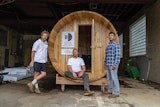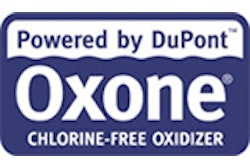
I recently read a market-survey summary from P.K. Data estimating that each year in the U. S. somewhere around 50,000 pools are demolished and filled in. Even as one who’s an admitted junkie for all manner of business analysis, facts and figures, that particular number, coming from an impeccably reliable source, pretty much hit like a hard-thrown rock.
Think about it – 50,000 – that’s not far from the total number of pools built each year. Such volume of activity practically amounts to an entire cottage industry dedicated to destroying our products! What’s next, a pool-demolition trade show or association?
How is that big a number even possible?
Stepping back from the ledge, there are a handful of fairly obvious reasons. Certainly the depressed state of the real-estate market would be one. Even now as the economy is clearly on the rebound with housing starts and prices on the rise, there remain far too many homes abandoned due to foreclosure. No doubt many of those properties contain ignored pools that have become empty eyesores or worse, left with nasty stews of algae- and mosquito-laden water. Not a pretty set of pictures, to say the least.
Another answer: many moribund pools are simply worn out, old, crumbling shells that no longer have any value to anyone. Let’s face it, for as spectacular as many of today’s pools have become, many of those built in years gone by were not much to look at in the first place, and many suffered problems stemming from inadequate engineering and installation as well as neglect.
Sobering as those mental images may be, I believe there’s an important takeaway, something we should seriously consider and even embrace. To boil it down to one word, the fact that so many of our industry’s products are abandoned and destroyed comes down to “relevance,” or in this context, lack of relevance.
It’s really just basic common sense (albeit of the depressing variety). When a pool is filled in, we can accurately deduce that it no longer has purpose in someone’s life. It has become irrelevant to the point where paying to destroy it makes more sense than investing in its repair, renovation or complete replacement.
On a strictly financial level, that means each year there are 50,000 fewer pools to service, repair, treat with chemicals or accessorize. One could probably crunch an estimate of annual loss to the aftermarket, but you get the picture. Beyond that, and arguably even more damaging in the long view, there are thousands and thousands fewer places where people enjoy the aquatic experiences that in turn form those cherished memories driving future demand.
With all those dumpsters of depressing gunk in mind, the eternal optimist in me can’t help but wonder what would it take to turn those 50,000 abandonments into renovations? Just imagine if, instead of seeing those vessels drop out of existence, someone believed they were valuable enough to invest in their revitalization. You don’t have to be much of a dreamer to visualize how our industry’s builder segment would be thriving with activity, along with retailers and servicers following that river of prosperity in the aftermarket.
[How I really do wish our industry would embrace the tremendous renovation opportunity with more passion and inspiration.] Even if a fraction of those pools were renovated instead of abandoned, we’d see a huge upsurge in activity that would send all our bitter memories of the recent great recession packing. In order to realize that kind of grand transition, however, to realize a future of unbridled prosperity – and I believe with all my heart it’s possible – we first must connect a variety of important dots.
Having recently entered my retirement years after nigh onto a half-century in our industry, I thought it would make sense to try and help out in the dot-connection department. For those of you who’ve followed my impassioned comments over the years, you already know I advocate elevating our industry by way of selling the joys of the pool and spa experience, as opposed to focusing on the nuts and bolts, or “spark plugs,” as I’m known to say.
For some, my brand of drumbeating may sound overly idealistic or even naïve. After all, cheerleading can only go so far. To my mind, however, the way we regard our products, how we think about them, talk about them, use them to inspire people, improve our customer’s lives, to make our world a better place, is not all just some fanciful basket of yarn, but in truth the ultimate fabric of practicality! It’s the mental material that comprises the psychology of demand.
Put another way, whether we realize it or not, consumer desire for the positive experiences our products provide is the very phenomena that keeps us in business. It’s why we are in business. We cannot escape the fact that in our universe, experience generates relevance, which is the basis for success. That’s true for our industry just as it is for everything from boating, to travel, to drinking coffee at Starbucks.
Unfortunately, ours also happens to be an industry that has consistently demonstrated an almost bizarre tendency to shy away from the very qualities that fuel the existence of pools and spas in the first place. That’s why changing course will require rethinking our leadership, trade associations, trade shows, marketing programs, relationships with related industries, participation in local communities and even how we think about ourselves.
That’s a whole bunch of rethinking and self-examination for sure and it won’t be easy. The big advantage we have, however, is that unlike other industries where clever marketers are forced to, shall we say, creatively synthesize their selling points, in our case, we don’t need to make up any of it, but merely embrace what already exists.
Yet, as it stands, we do need to analyze why each year so many of our products give new literal meaning to the term landfill. Certainly not easy to face, but part of overcoming that dispiriting situation will involve looking in the mirror and owning the fact it’s really our fault. Given how boring some of those old structures were, completely lacking in any level of design panache, coupled with what a lousy job we’ve done of promotion, perhaps saying good riddance to the past is exactly what we need to do.
The big caveat when reacting to the past for future’s sake, however, is we must always look ahead from an entirely constructive perspective, or risk being destined to repeating the same mistakes. Rather than simply wallowing in our past shortcomings and failures, we should be brave enough to learn the hard lessons and ultimately believe in the truth behind the old adage that in every problem resides opportunity. If we are willing to change collectively and individually, there is absolutely no reason to believe the status quo is immovable.
That’s a big if, but also why I believe with the deepest convictions and brightest of outlooks, there exists a path forward to a landscape where our expansion is propelled by the gravity of relevance and filled with the waters of experience.
And as we saunter down that path we can be certain the journey will be much more fun than sitting still while being filled with dirt and covered with gravel.
Vance Gillette is an outspoken proponent of the pool and spa experience. An industry leader with 47 years experience, he has traveled extensively throughout U.S., Europe, Canada and Australia representing such prominent firms as Arneson Products, Jandy Products, Teledyne Laars, and most recently as the vice president of business development for Zodiac Pool Systems.
Now semi-retired, he maintains an active presence via social media outlets including Facebook, Blogger, Twitter, Youtube Channel, Pinterest, Houzz, LinkedIn and others, where he shares notable information and stunning images of water design elements.











































